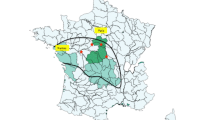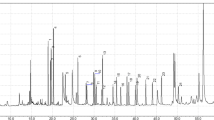Abstract
Samples were analyzed for 12 organochlorine chemicals. Concentrations of DDT + DDD and dieldrin in American white pelican(Pelecanus erythrorhynchos) eggs collected at the Klamath Basin National Wildlife Refuges decreased from 1969 to 1981; DDE and polychlorobiphenyl (PCB) residues did not significantly change. Differences between PCB residues in eggs collected from Lower Klamath and Clear Lake colonies in 1969 suggest different migration routes or wintering areas between populations nesting at these two locations. White pelican and western grebe(Aechmophorus occidentalis) PCB/DDE ratios were 0.13 and 1.58, respectively, suggesting different exposure patterns. White pelican eggshell thickness increased between 1969 and 1981, but remained significantly less than pre-1947 values. Western grebe shell thickness was not significantly different from pre-1947 values. Endrin caused some of the pelican mortalities in the Klamath Basin from 1975 to 1981. Pelicans may have acquired endrin in California, but possibly from areas outside of the Klamath Basin.
Similar content being viewed by others
References
Abou-Donia MB, Menzel DB (1968) The metabolismin vivo of 1,1,1-trichloro-2,2-bis-(p-chlorophenyl)ethane (DDT), 1,1- dichloro-2,2-bis-(p-chlorophenyl)ethane (DDD) and 1,1- dichloro-2,2-bis(p-chlorophenyl)ethylene (DDE) in the chick by embryonic injection and dietary ingestion. Biochem Phar- macol 17:2143–2161
Anderson DW, Hickey JJ (1972) Eggshell changes in certain North American birds. In: Voous, KH (ed) Proc XVth Inter Ornithol Congr. EJ Brill, Leiden, The Netherlands, pp 514–540
Anderson DW, Hickey JJ, Hughes DL (1969) Significance of chlorinated hydrocarbon residues to breeding pelicans and cormorants. Can Field-Nat 83:91–112
Anderson DW, Raveling DG, Risebrough RW, Springer AM (1984) Dynamics of low-level organochlorines in adult cackling geese over the annual cycle. J Wildl Manage 48:1112–1127
Anonymous (1974) Federal Register 39:37,246
Anonymous (1982) DDT at contaminant level may cause egg- shell thinning, EPA-er says. Pestic Toxic Chem News 10(43):6–7
Blus LJ (1982) Further interpretation of the relation of organo- chlorine residues in brown pelican eggs to reproductive success. Environ Pollut (Series A) 28:15–33
Boellstorff, DE (1983) Pollutants, mortality, and eggshell thin- ning in white pelicans and western grebes in northern California. MS Thesis, University of California, Davis
California Department of Food and Agriculture (1982) Pesticide use report: annual 1981. Calif Dept Food Agric, Sacramento, 274 pp
Cromartie E, Reichel WL, Locke LN, Belisle AA, Kaiser TE, Lamont TG, Mulhern BM, Prouty RM, Swineford DM (1975) Residues of organochlorine pesticides and polychlo- rinated biphenyls and autopsy data for bald eagles, 1971–1972. Pestic Monit J 9:11–14
Cummings JG, Eidelman M, Turner V, Reed D, Zee KT, Cook RE (1967) Residues in poultry tissues from low level feeding of five chlorinated hydrocarbon insecticides to hens. J Assoc Off Anal Chem 50:418–425
Fleming, WJ, McLane MAR, Cromartie E (1982) Endrin de- creases screech owl productivity. J Wildl Manage 46:462–468
Godsil PJ, Johnson WC (1968) Pesticide monitoring of the aquatic biota at the Tule Lake National Wildlife Refuge. Pestic Monit J 1:21–26
Heinz GH, Johnson RW (1979) Elimination of endrin by mallard ducks. Toxicology 12:189–196
Jackson GA (1976) Biologic half-life of endrin in channel catfish tissues. Bull Environ Contam Toxicol 16:505–507
Kaiser TE, Reichel WL, Locke LN, Cromartie E, Lamont TG, Mulhern BM, Prouty RM, Stafford CJ, Swineford DM (1980) Organochlorine pesticides, PCB, PBB residues, and nec- ropsy data for bald eagles from 29 states—1975–1977. Pestic Monit J 13:145–149
Keith JO (1966a) Insecticide contaminations in wetland habitats and their effects on fish-eating birds. J Appl Ecol 3(Suppl):71–85
— (1966b) The effect of pesticides on populations of white pelicans. Unpub ms presented at Fourth Conf on Use Agric Chem in Calif, Davis, California
Kridler E (1960) Banding white pelicans at Anaho National Wild- life Refuge, Nevada. News from the Bird Banders 35:5–6
Lehner PN, Egbert A (1969) Dieldrin and eggshell thickness in ducks. Nature 224:1218–1219
Mason JW, Rowe DR (1976) The accumulation and loss of diel- drin and endrin in the eastern oyster. Arch Environ Contam Toxicol 4:349–360
McCleneghan K, Meinz M, Crane D, Seto W, Lew T, Hansen RJ (1981) Toxic substances monitoring program, 1980. State Water Res Con Board, Sacramento, California, Water Qual Monit Rep 81-8TS 56 pp + 6 App
Mendenhall VM, Klaas EE, McLane MAR (1983) Breeding suc- cess of barn owls(Tyto alba) fed low levels of DDE and dieldrin. Arch Environ Contam Toxicol 12:235–240
Mora MA (1984) Seasonal and geographical variation of organo- chlorines in waterfowl from California and Mexico. MS Thesis, University of California, Davis
Neter J, Wasserman W (1974) Applied Linear Statistical Models. Richard D Irwin, Inc, Home wood, IL, 842 pp
Ohlendorf HM, Miller MR (1984) Organochlorine contaminants in California waterfowl. J Wildl Manage 48:867–877
Ohlendorf HM, Risebrough RW, Vermeer K (1978) Exposure of marine birds to environmental pollutants. US Fish and Wildl Ser, Wildl Res Rep 9, 40 pp
O'Malley JBE, Evans RM (1980) Variations in measurements among white pelican eggs and their use as a hatch data predictor. Can J Zool 58:603–608
Pillmore RE (1961) Pesticide investigations of the 1960 mortality of fish-eating birds on Klamath Basin wildlife refuges. US Fish and Wildl Serv, Denver Wildl Res Lab, Denver, CO, 12 pp
Risebrough RW, Anderson DW (1975) Some effects of DDE and PCB on mallards and their eggs. J Wildl Manage 39:508–513
Risebrough RW, Reiche P, Peakall DB, Herman SG, Kirven MN (1968) Polychlorinated biphenyls in the global ecosystem. Nature, London, 220:1098–1102
Ryan TA Jr, Joiner BL, Ryan BF (1976) MINITAB Student Handbook. Duxbury Press, North Scituate, Mass, 341 pp
Sileo L, Karlstad L, Frank R, Holdrinet MVH, Addison E, Braun HE (1977) Organochlorine poisoning of ring-billed gulls in southern Ontario. J Wildl Dis 13:313–322
Stickel LF (1973) Pesticide residues in birds and mammals. In: Edwards, CA (ed) Environmental pollution by pesticides. Plenum Press, London and New York, pp 254–312
Stickel LF, Wiemeyer SN, Blus LF (1973) Pesticide residues in eggs of wild birds: adjustment for loss of moisture and lipid. Bull Environ Contam Toxicol 9:193–196
Stickel WH, Reichel WL, Hughes DL (1979) Endrin in birds: lethal residues and secondary poisoning. In: Deichmann WB (ed) Toxicology and occupational medicine. Elsevier, North Holland, NY, pp 397–406
U.S. Environmental Protection Agency (1979) Suspended and cancelled pesticides. Unnumbered publication prepared by Pesticides and Toxic Substances Enforcement Division Sci- entific Support Team, Washington, DC, 35 pp
Walker CH, Jefferies DJ (1978) The postmortem reductive de- chlorination ofp p′DDT in avian tissues. Pestic Biochem and Physiol 9:203–210
Woods PC, Orlob GT (1963) The Lost River system—a water quality management investigation. Water Resources Center Contrib No. 68, University of California, Berkeley, 54 pp
Author information
Authors and Affiliations
Rights and permissions
About this article
Cite this article
Boellstorff, D.E., Ohlendorf, H.M., Anderson, D.W. et al. Organochlorine chemical residues in white pelicans and western grebes from the klamath basin, california. Arch. Environ. Contam. Toxicol. 14, 485–493 (1985). https://doi.org/10.1007/BF01055535
Received:
Revised:
Issue Date:
DOI: https://doi.org/10.1007/BF01055535




